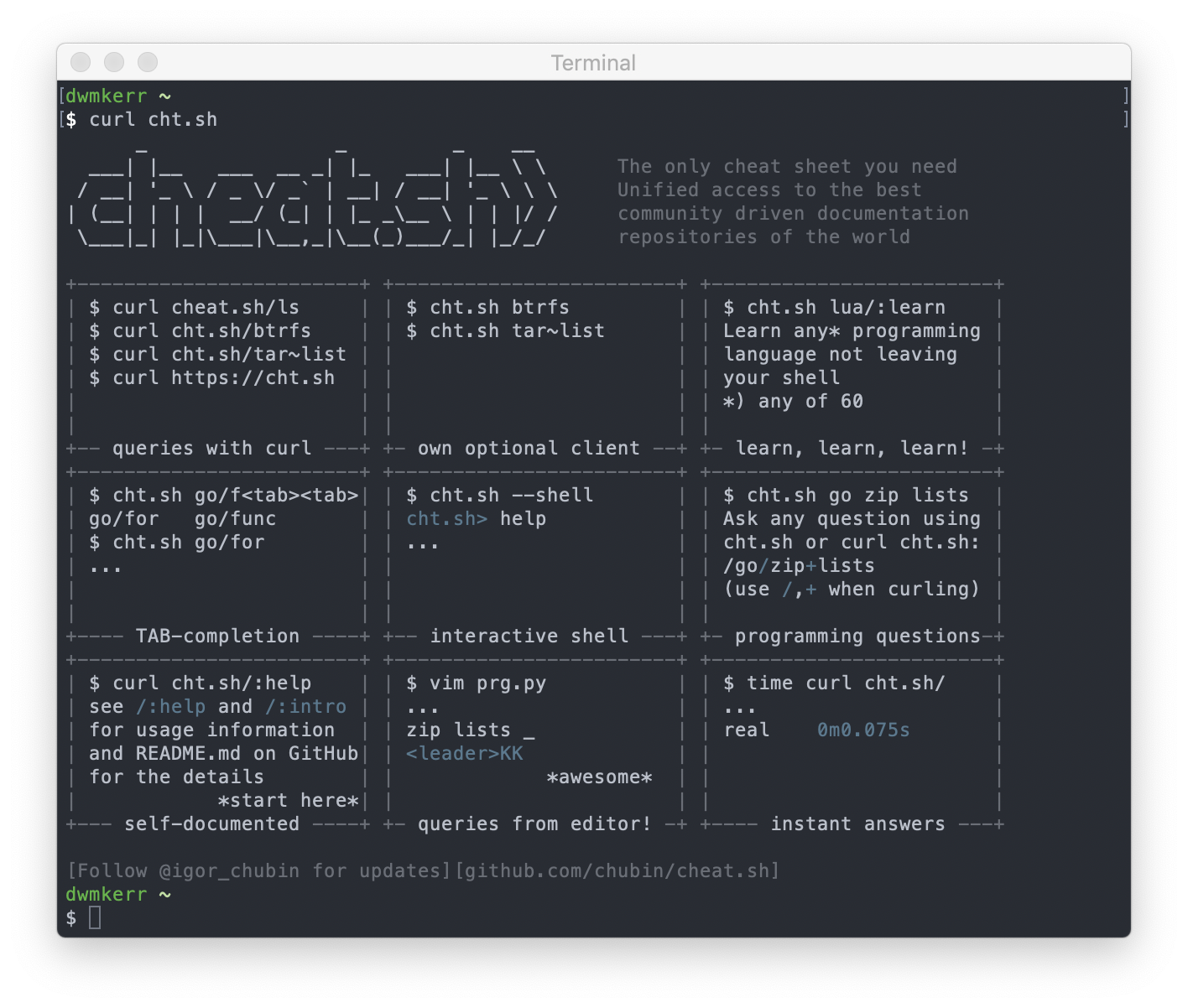Getting Help
In the earlier chapters I've introduced quite a few commands. Having to remember all of these commands and their parameters would be very hard. Fortunately there are built-in capabilities in the shell to help.
In this chapter I'll show you how to quickly get help when working with tools in the shell, without disrupting your flow!
Getting Help is Important!
If you are trying to be more effective when using the shell, it is crucial to know how to quickly look things up.
There'll be many circumstances where you'll need to open a browser to search for help. But there's also a wealth of information only a few keystrokes away. Looking up parameters, checking how to run commands, C library documentation, or even useful information like ASCII charts are available directly in the shell.
Being able to access this information quickly, without jumping into a browser or interrupting your flow is going to be one of the most crucial things you can do to become an effective shell user.
First we're going to look at the standard help system which is available on all Unix-like systems, which is man (short for 'manual'). Then we'll see a useful tool you can installed called tldr, which might be more helpful for day-to-day use. Finally we'll take a look at the cht.sh site as an alternative source for help.
Understanding 'man'
Most tools you encounter in the shell have manual pages available. Many people will be familiar with the man command to get help on a tool, but there is a lot more help available than people often realise.
Getting help on a command
The most basic way to get help on a command is with man. Here's an example:
$ man cp
CP(1) BSD General Commands Manual CP(1)
NAME
cp -- copy files
SYNOPSIS
cp [-R [-H | -L | -P]] [-fi | -n] [-apvX] source_file target_file
cp [-R [-H | -L | -P]] [-fi | -n] [-apvX] source_file ...
target_directory
DESCRIPTION
In the first synopsis form, the cp utility copies the contents of the
source_file to the target_file. In the second synopsis form, the con-
tents of each named source_file is copied to the destination
target_directory. The names of the files themselves are not changed. If
cp detects an attempt to copy a file to itself, the copy will fail.
...
The man command opens the manual for the given tool. These manuals should contain all command line options and details of how to use the tool.
You can scroll up and down through the content with the arrow keys. This scrolling capability actually is not part of man - it is available because the information is presented in the shell pager. A pager is a tool for looking through content which might not easily fit on a screen.
Using the pager
The first thing you might notice is that you can move through the manual pages with the arrow keys.
The man command finds the appropriate manual page (often shortened to 'manpages') and then opens the page in a pager tool. The pager is what is providing the keyboard interface to look through the file.
On most systems, the pager will be the less program. There are lots of commands you can use to navigate through files with less, but the bare essentials are:
d- Scroll down half a pageu- Scroll up half a pagej/k- Scroll down or up a line. You can also use the arrow keys for thisq- Quit/<search>- Search for textn- When searching, find the next occurrenceN- When searching, find the previous occurrence
There are many other commands, but the set above is normally what I find myself using the most.
If you are interested, you can actually see what your pager is with the command below:
$ echo $PAGER
less
The $PAGER environment variable is used to tell the shell what program to use for paging. A few more details can be found with the man man command.
You can put any text content into your pager - try this:
ls -al /usr/bin | less
This lists the contents of the /usr/bin folder, piping the output to less so we can easily scroll through it.
There are alternative pagers available (on many Unix-y systems you'll have less, more and most) but in general you'll normally get what you need with less.
The Alternative - Help
Sometimes you'll look something up in the manual and get the 'builtins' page. For example:
$ man cd
BUILTIN(1) BSD General Commands Manual BUILTIN(1)
NAME
builtin, !, %, ., :, @, {, }, alias, alloc, bg, bind, bindkey, break,
breaksw, builtins, case, cd, chdir, command, complete, continue,
## (I've skipped the bulk of the output to save space!)
This happens when the command you are looking up is not actually a program with a manual page, but a built-in shell command. Most shells have a way get help on such commands - bash for example has help:
$ help cd
cd: cd [-L|[-P [-e]] [-@]] [dir]
Change the shell working directory.
Change the current directory to DIR. The default DIR is the value of the
HOME shell variable.
# (I've skipped the bulk of the output to save space!)
This is all I'll say about help for now. We visit it again in Chapter 10 - Understanding Commands, where we talk more about built-in commands. For now we'll go back to the man command, which works across all shells as it is a Linux feature rather than a shell specific feature!
Manual Sections
You'll often see tools referred to in manpages with numbers after them. Take a look at man less:
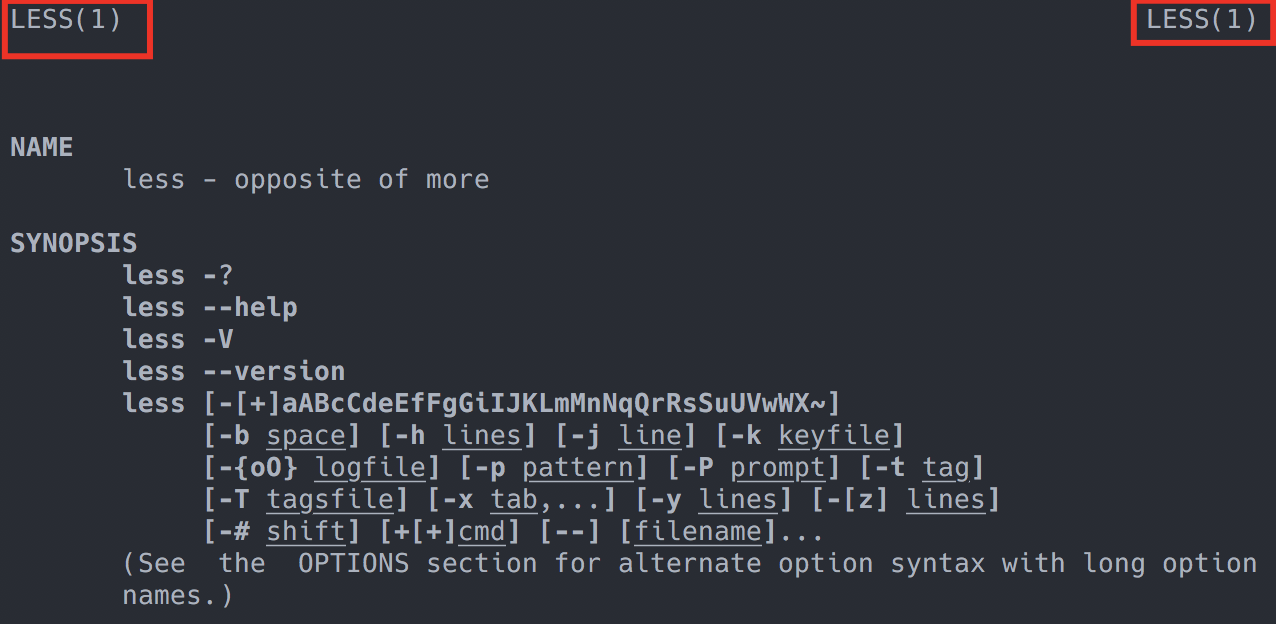
The number is the manual Section Number. The different sections of the manual are documented and can be found on most Unix-like systems in man's documentation, which you can check by running man man1. Here's what you'd get on Ubuntu 16:
- Section 1 - Executable programs or shell commands
- Section 2 - System calls (functions provided by the kernel)
- Section 3 - Library calls (functions within program libraries)
- Section 4 - Special files (usually found in
/dev) - Section 5 - File formats and conventions (e.g.
/etc/passwd) - Section 6 - Games
- Section 7 - Miscellaneous (including macro packages and conventions), e.g.
man(7),groff(7) - Section 8 - System administration commands (usually only for root)
- Section 9 - Kernel routines (Non standard)
Not all of these explanations will be entirely clear to everyone, so we'll go through the sections in detail shortly.
If you want to, you can specifically choose which section of the manual you are looking in by using:
man <section> <search>
You can also get more information about the sections themselves by opening up the intro page. For example:
$ man 1 intro
INTRO(1) BSD General Commands Manual INTRO(1)
NAME
intro -- introduction to general commands (tools and utilities)
DESCRIPTION
Section one of the manual contains most of the commands which comprise...
Why would you do this, and why would you care? In general you won't need to worry about the sections unless you are looking for something which has an entry in multiple sections and you want to specify which one you use.
Another reason it is useful to know about the sections is that a lot of documentation (online and offline) includes a section number after the name of a command or file. Knowing what the section is can be useful in this case.
Here are a few examples of entries from each section, which illustrate what each section is for.
Section 1: Programs and Shell Commands
These are programs - probably what you are going to be looking up most regularly! For example, man 1 time shows:
TIME(1) BSD General Commands Manual TIME(1)
NAME
time -- time command execution
SYNOPSIS
time [-lp] utility
DESCRIPTION
The time utility executes and times utility. After the utility finishes, time writes the total time
elapsed, the time consumed by system overhead, and the time used to execute utility to the standard
error stream. Times are reported in seconds.
...
Section 2: System Calls
You'll probably not use this section unless you are doing systems programming2. This section contains info on the available Linux Kernel system calls. For example, running man 2 chown gives:
CHOWN(2) BSD System Calls Manual CHOWN(2)
NAME
chown, fchown, lchown, fchownat -- change owner and group of a file
SYNOPSIS
#include <unistd.h>
int
chown(const char *path, uid_t owner, gid_t group);
...
This entry shows you how you would call the function if you were programming for the Kernel.
Section 3: Library Calls
These are the manpages for the C standard library functions. For example, man 3 time:
TIME(3) BSD Library Functions Manual TIME(3)
NAME
time -- get time of day
LIBRARY
Standard C Library (libc, -lc)
SYNOPSIS
#include <time.h>
time_t
time(time_t *tloc);
...
You would use this information if you were writing programs to run on the system.
Here we can see why the sections are important to know about. There are multiple entries for time. We need to use the sections to differentiate between them.
Running man time would not open the page above, because man searches the library in ascending section order, meaning that it actually finds time(1) and shows the pages for the time program, not the time C library call.
Because of the potential ambiguity of names if no section number is included, in lots of Linux documentation you'll see the man section number written next to library calls, system calls, programs and so on (things will refer to sed(1) or time(3) for example.
Section 4: Devices
This section deals with the special devices which live in the /dev/* folder. For example, running man 4 random shows:
RANDOM(4) BSD Kernel Interfaces Manual RANDOM(4)
NAME
random , urandom -- random data source devices.
SYNOPSIS
pseudo-device random
DESCRIPTION
The random device produces uniformly distributed random byte values of
potentially high quality.
...
Again, we see that section numbers can be important. If you just run man random, you'll see:
RANDOM(3) BSD Library Functions Manual RANDOM(3)
NAME
initstate, random, setstate, srandom, srandomdev -- better random num-
ber generator; routines for changing generators
LIBRARY
Standard C Library (libc, -lc)
SYNOPSIS
#include <stdlib.h>
char *
initstate(unsigned seed, char *state, size_t size);
long
random(void);
...
Which is the manpage for random(3), which is C library function, not the /dev/random file!
We'll see more of these special files later in the book.
Section 5: File Formats
This section details special files in the system. For example, man 5 crontab shows:
CRONTAB(5) BSD File Formats Manual CRONTAB(5)
NAME
crontab -- tables for driving cron
DESCRIPTION
A crontab file contains instructions to the cron(8) daemon of the gen-
eral form: ``run this command at this time on this date''. Each user
has their own crontab, and commands in any given crontab will be exe-
cuted as the user who owns the crontab. Uucp and News will usually
have their own crontabs, eliminating the need for explicitly running
su(1) as part of a cron command.
...
Which describes the crontab file used to define scheduled tasks. Again, this is different to man crontab which would document crontab(1). Similarly, man 5 passwd is going to show something quite different to man passwd.
You'll potentially use this section if you are performing system administration.
Section 6: Games
Nothing says it better than man 6 intro itself (this'll not work on a Mac sadly, but try it on another Linux system):
...
DESCRIPTION
Section 6 of the manual describes all the games and funny little programs available on the system.
...
There are probably a few silly programs available on your system, here you'll find their manuals. For example, man 6 banner on a Mac shows:
BANNER(6) BSD Games Manual BANNER(6)
NAME
banner -- print large banner on printer
SYNOPSIS
banner [-d] [-t] [-w width] message ...
DESCRIPTION
Banner prints a large, high quality banner on the standard output. If
the message is omitted, it prompts for and reads one line of its stan-
dard input.
...
This section is going to be highly dependent on your operating system!
Section 7: Miscellaneous
This is where you'll find additional assorted documentation. For example, man 7 ascii shows:
ASCII(7) BSD Miscellaneous Information Manual ASCII(7)
NAME
ascii -- octal, hexadecimal and decimal ASCII character sets
DESCRIPTION
The octal set:
000 nul 001 soh 002 stx 003 etx 004 eot 005 enq 006 ack 007 bel
...
Section 8: System Commands
We've actually already seen one of these commands mentioned, in the manpage for crontab(5) it mentions cron(8). Let's see, with man 8 cron:
CRON(8) BSD System Manager's Manual CRON(8)
NAME
cron -- daemon to execute scheduled commands (Vixie Cron)
SYNOPSIS
cron [-s] [-o] [-x debugflag[,...]]
These are commands which system administrators would normally run. You might open section eight unexpectedly, for example man chmod will open chmod(1), but man chown will open chown(8), as it is a system command.
Some distributions might vary for section nine. On my Mac it contains information about the kernel interfaces, a C style guide and some more.
Getting the Index of Manual Section
Manpages are just files on the filesystem, so you can get the index of a section just by looking in the appropriate folder.
For example, to index the available system calls, try ls /usr/share/man/man2:
EV_SET.2
FD_CLR.2
FD_COPY.2
FD_ISSET.2
FD_SET.2
FD_ZERO.2
_exit.2
accept.2
access.2
acct.2
...
This is quick and easy way to see what sort of entries you have on your system. If you want to work out where an entry lives, use the -w flag:
$ man -w printf
/usr/share/man/man1/printf.1
There are other ways to show the index of each section, but they vary a lot from system to system so showing the actual files is probably easier.
Searching the Manual
You can search the manpage titles and summaries with man -k. For example, man -k cpu shows:
cpuwalk.d(1m) - Measure which CPUs a process runs on. Uses DTrace
dispqlen.d(1m) - dispatcher queue length by CPU. Uses DTrace
gasm(n), grammar::me::cpu::gasm(n) - ME assembler
You can find more advanced options for searching by using your newfound man skills on man itself.
You can also use the apropos or whatis commands to search through the manuals. However, for simplicity I suggest just remember man -k!
Introducing tl;dr
In general for this book I'm trying to avoid suggesting too many non-standard tools which don't come pre-installed on systems. However, this one is just too good to miss!
Let's say I need to find and replace some text in a file. I know I can do this with the sed command, but have forgotten the syntax. So I run man sed:
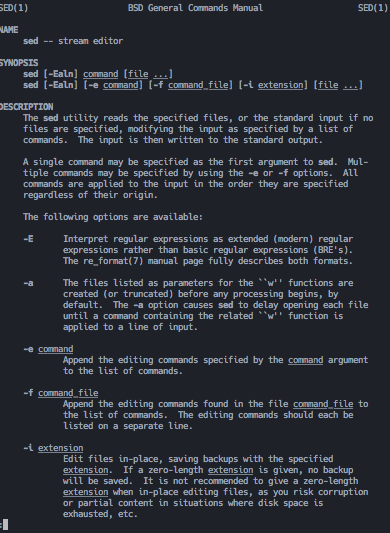
Wow, that's a lot of detail! And this is just page one of six!
Now let's compare this to the output from tldr (which is short for "Too Long, Didn't Read"). All I need to do is run tldr sed:
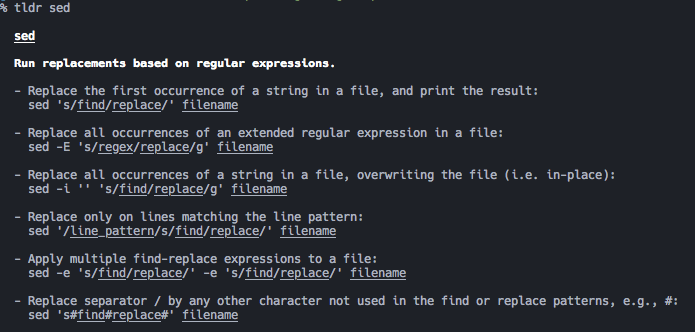
The first example is exactly what I'm looking for. Now for any more detail than a few basic examples, I'm going to have to go to the manual, but for the basics this is great.
You can install the tldr tool with npm install -g tldr. It's open source and community maintained. You will need Node.js installed to install the tool, the instructions are available online.
I'd recommend tldr as a first-call for checking to see how to use a command.
The Online Cheatsheet
One final resource which I think is worth sharing is the website www.cheat.sh. This is a fantastic online collection of 'cheat sheets'.
These sheets cover almost all of the tools you will encounter, programming languages and more. But the real beauty of the tool is how it integrates into the shell. To see what I mean, just run the following command:
$ curl cht.sh
You will see something like this:
The curl command we'll see again and again. It is a tool which lets you download content from the web. If we load the cheat.sh website (or its shortened version, cht.sh) from the shell, we get a text version of the website. We can now look at all sorts of content by following the guide shown.
The Cheat.sh site aggregates many data sources - including tldr! This means we can get information on tools without even having to install a tool like tldr locally.
This online cheatsheet is a wonderful resource. As well as guides for specific tools, there are entire courses on programming languages. You can even use it to search for the answers to questions, these features are powered by Stack Overflow. For example:
$ curl cht.sh/"How do I copy a folder in bash?"
You'll see something like this:
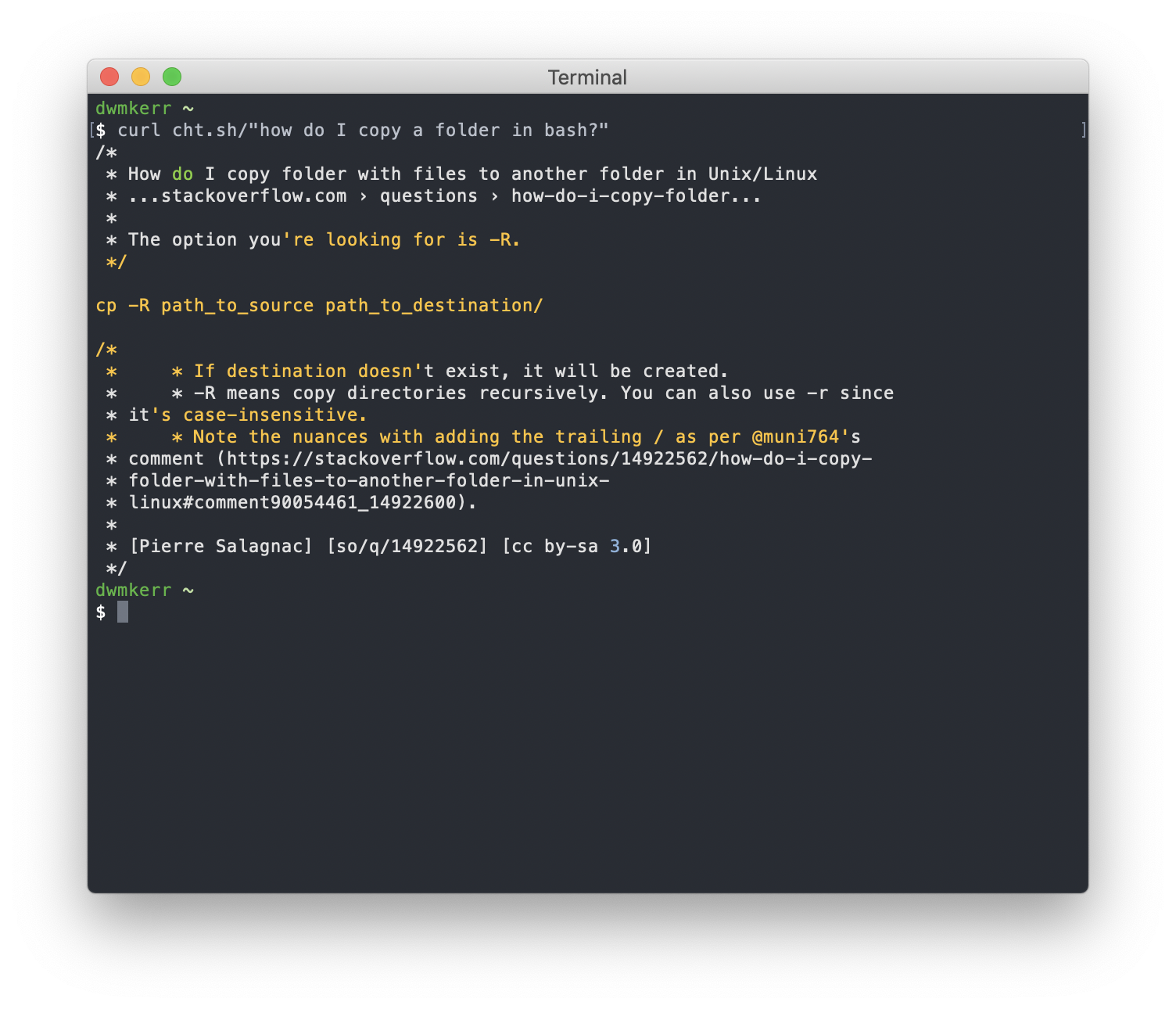
Now that can be a real time saver!
Summary
In this chapter we looked at some of the ways we can get help. To quickly summarise:
- The
mantool can be used to look at the manual page for a topic - The
manpages are grouped into sections, we can see them withman man - The
tldrtool shows a very short description of a tool, which covers the most common use cases only - The
cht.shwebsite can be used directly from the shell to get help on tools or even ask specific questions
